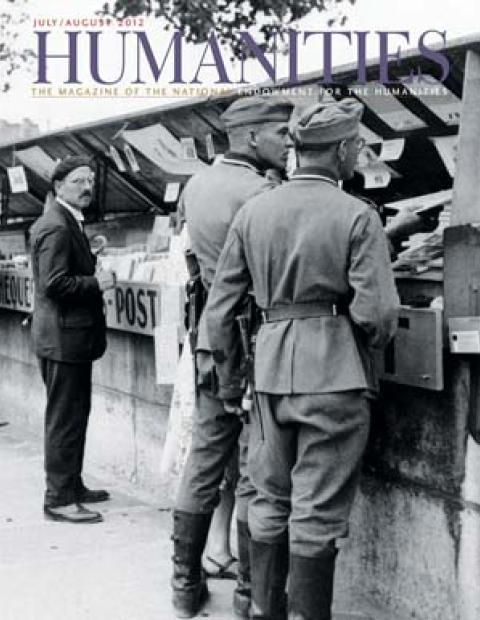One was a social critic who inspired the term “muckraker.” One launched an empire based entirely on promoting good manners. And another changed the hip-hop world forever. What could Upton Sinclair, Emily Post, and Tupac Shakur possibly have in common?
They all lived, worked, or found inspiration in Baltimore’s historic Mount Vernon neighborhood.
“Mount Vernon is such a beauty for Baltimore, but so many people don’t know its history,” says Josephine Williams, tour guide and former Maryland Humanities Council’s executive director. With a goal of increasing public awareness about the neighborhood’s rich history, she and colleague Lisa Kier created the Maryland Humanities Council literary walking tour of Mount Vernon.
The tour commences at the Enoch Pratt Free Library, just blocks away from the heart of historic Mount Vernon Square. There, participants learn how this accessible and unpretentiously designed library served as an intellectual refuge for the poor and working class during the Great Depression. “This is a tour about writers and buildings,” says Williams, who then reveals this was the place where Pulitzer Prize-winning poet Karl Shapiro got his start.
The nearby George Peabody Library served a similar purpose for John Dos Passos. Housed in a sprawling, elegant building begun by philanthropist George Peabody in 1857, the Peabody was established to make culture accessible to all. This mission resonated with Dos Passos, who dedicated his literary career to exploring the ins and outs of American culture through fiction. Upon entering the library, tour participants can even see the desk he often wrote at for nine-hour stretches at a time.
While Dos Passos was pioneering his own style of nonlinear fiction, another iconic writer was working less than a block away. A post-Gatsby F. Scott Fitzgerald was living at the Stafford Hotel, where he completed what would be his last finished novel, Tender Is the Night. A decade of extravagance and indulgence had caught up with the Fitzgeralds by this point—F. Scott’s alcoholism was worsening, and Zelda was hospitalized for schizophrenia.
Perhaps the Fitzgeralds’ misfortunes would have been less if longtime friend Gertrude Stein had been nearby. And so she was—but a few decades earlier. As a young woman at the turn of the century, Stein was one of the few women enrolled in medical school at Johns Hopkins University. Other pioneering women such as poet Edna St. Vincent Millay and etiquette queen Emily Post also spent time in Mount Vernon.
And what would a literary neighborhood be without its critics? Upton Sinclair, author of The Jungle, spent the first decade of his life in a boardinghouse in Mount Vernon. Shortly after Sinclair left Baltimore for New York City, former slave John H. Murphy founded the Afro American in 1892. The publication originally started out serving Baltimore’s African-American community, but it gained a national audience under the leadership of Murphy’s son by publishing prominent black thinkers such as Langston Hughes, Romare Beardon, and Sam Lacy.
This opened the door for black literature to be published in a wider range of publications. H. L. Mencken, who spent his early professional years in Mount Vernon, became one of the first editors to publish black work in predominately white journals. By the time rapper Tupac Shakur attended the Baltimore School for the Arts in the 1980s, race relations had changed dramatically, yet the iconic lyrics he would write just a few years after his time in Mount Vernon reminded a new generation there was still much to be done.
While not all the subjects of the tour were lifetime residents of Mount Vernon, the neighborhood played a role in shaping their thoughts, styles, and values. For some, such as Upton Sinclair and Emily Post, Mount Vernon was their first introduction to the world. For others, like Karl Shapiro and John Dos Passos, the hospitality of its public buildings provided a quiet sanctuary for them to pen some of their most impressive works. And for famed expatriates such as Henry James and F. Scott Fitzgerald, Mount Vernon served as their entry point back into the United States.
Now in its fifth season, the literary tour was made possible after the council received a Heritage Area Grant through the Maryland Historic Trust. The council then hired Baltimore artist Tom Chalkley to draw up a map of the neighborhood and launched the first tour in autumn of 2007. Originally planned as a supplement to the Baltimore Book Festival, the tour soon grew into an event in and of itself, attracting local, regional, and even international participants. To accommodate this burgeoning interest, tours are now offered free to the public the third weekend of each month, from April through September.
Mount Vernon today is not much different from the way it was a hundred years ago. It is still one of the artistic hubs of the city and, with Johns Hopkins University and the Maryland Institute College of Art, remains one of the city’s epicenters of intellectual activity. While new restaurants, boutiques, and cafes have sprouted up, they coexist with the historical landmarks and original flair of the neighborhood. “It’s a miracle that in a city like this all this still exists,” Williams reflects.


